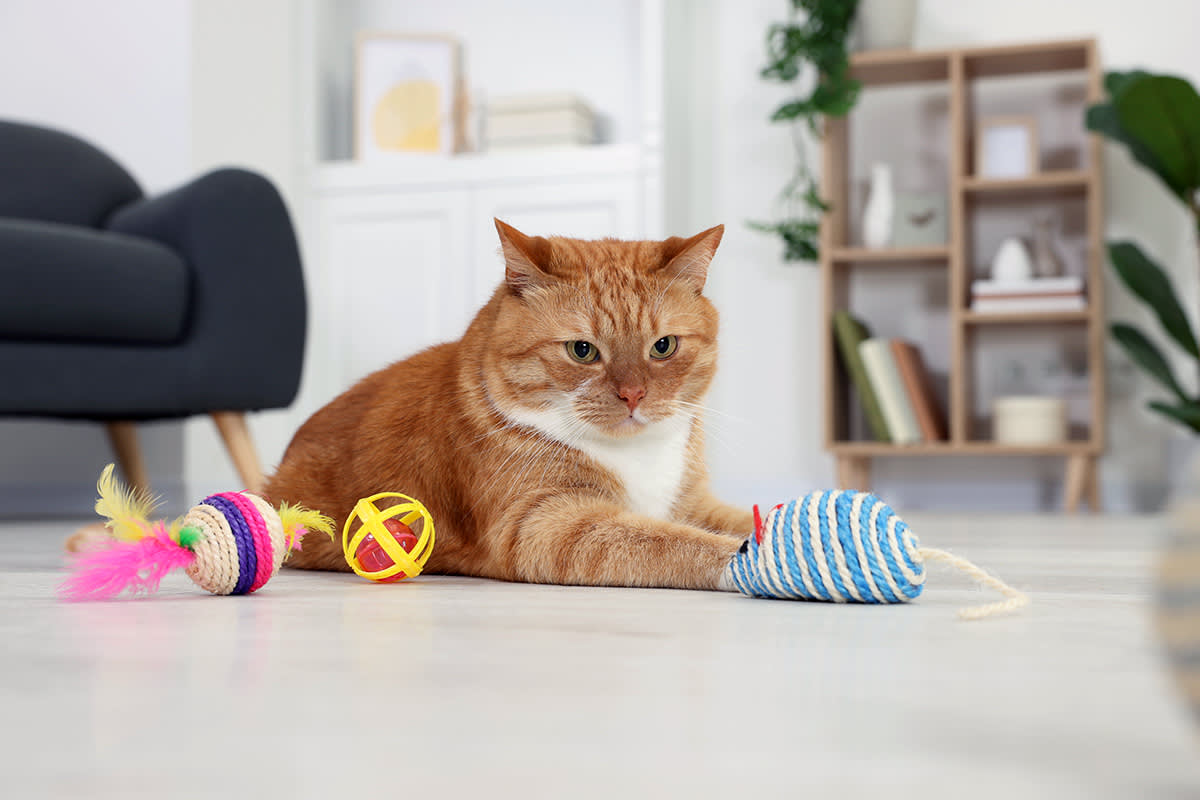Cats Can’t Stand These Textures—They Have Very Sensitive Paws
It's not just crumpled tin foil.

Share Article
Cats are very particular creatures, and if you want to make your home as warm and inviting a place for them as possible, you need to understand their preferences. This isn’t just about the food they eat or where they like to sleep, but the textures that make them purr (and the ones that give them the ick).
Cats have extremely sensitive paw pads full of nerve endings. “They use their paws to explore the world around them,” says Jennifer Van de Kieft, a feline behaviorist and feeding coach at Cat Advocateopens in new tab. “When they encounter something new, they reach out their paws to investigate it, just like we do with our hands.” Their skin and hair are also much more sensitive than ours, which is probably what makes being pet so pleasurable for many of them and overstimulating for others.
“In general, they like soft things,” Van de Kieft says: fluffy things, fleecy things, pillows, carpets, down comforters, and bed sheets. Surfaces they can nuzzle into that won’t catch and pull at their fur. Sometimes, they like smooth surfaces like cardboard or hardwood floors, but this probably has more to do with the fact that these surfaces are cool to the touch than that they are pleasant textures.
Cats hate feeling uneasy.
Cats like surfaces they can sink their claws into. This allows them to spring into action at a moment’s notice. Smooth surfaces are more difficult for them to navigate, and if you’ve got a particularly skittish or shy cat, they may feel insecure walking on these types of materials. You may also notice that they avoid such surfaces or stay low and close to the walls when traversing them.

Cats love scratching and need to scratch something in order to shed their claws. Exactly what they choose to scratch, though, depends on their personal preferences. Some cats like ripping up cardboard scratchers. Others hate it. Some like bamboo mats or rope-covered scratching posts, while others won’t even touch them.
“I bought some bamboo cat-scratcher mats,” cat dad Sam says. “They have been on the floor for weeks, covering the spots on the carpet that she kept ripping up, and my cat will do anything not to step on them. She absolutely hates them. It is funny to see her go into my office by squeezing her paws onto the small inch of carpet around the door.”
If you don’t find a good scratching option for your cat, they will scratch up your furniture, so it’s important to find something that works for them. The thing that is so appealing about furniture and rugs for scratching is that they are soft, plush, and sturdy. Often they are large, so your cat can stretch out while having a scratch, and they are heavy, so they stay in place no matter how hard your cat tugs.
Finding a scratcher that meets all these criteria and looks good in your home is easier said than done, which is why a friend of mine once bought a thick piece of wood, upholstered it, and mounted it to her wall to give her cat something aesthetically pleasing to sink his claws into. She also sprayed it with catnip spray and gave him a treat every time he used it for the first couple of weeks.
And if they hate it, they’ll let you know.
I just bought a leather couch. My cats were much less interested in scratching that than my old cloth-covered couch. Unfortunately, they were also much less interested in spending time on the new leather couch, probably because it was much firmer and more slick than the fabric couch had been.
They hate plastic.
A lot of cats dislike the feel of plastic (even if they are prone to chew on it), so a plastic sticker can often be a good way to discourage cats from trying to scratch the arm of the sofa.
And they detest sticky, pointy, and spiky things.
Even rounded points can be unpleasant for them because of how sensitive their paws are. This is why people will sometimes put spiky, nubby, or sticky objects in places they don’t want their cats to be, like on bookshelves, in planters, or on counters, tables, and chairs. This tactic can sometimes backfire, though.
If your home becomes uninviting, if there are too many places your cat can’t or doesn’t want to be, and not enough places where they can and do want to be — soft places, high places, hiding places — Van de Kieft warns that they may start acting out. Not because they are trying to get back at you — cats are not vengeful creatures; that’s not how their brains work — but because they feel uncomfortable and are trying to make space for themselves or self-soothe in whatever way they can.
As for tin foil, which the internet loves to offer as a solution for keeping cats off counters, in Van de Kieft’s experience, it’s seldom effective. “Some cats dislike it, but many are not fazed by it at all,” she says. If you crumple it up, it will be spiky and sharp, which cats dislike, but laying it out smooth probably won’t do much. And there are other, more effective, ways to train them off the counters anyway.
Pay attention to litter texture.
There are all sorts of litter: pellets, gravel, sand, granular corn- or olive-based litters. But when it comes to litter, for the vast majority of cats, the rule is: the softer, the better. Meaning small grain sand-like litter reigns supreme. “Cats are from the desert, so the softer and sandier the litter, the more they like it,” Van de Kieft says.
People often reach out to Van de Kieft for help when their cats start going to the bathroom outside of their litter boxes, and the first thing she asks them is what kind of litter they are using. “You’d be amazed how often changing to a softer, sandier litter solves the problem,” she says.
And if you’re worried about your cat ingesting the dust that is a byproduct of all sandy litters, don’t. “I’ve never actually seen this be an issue,” Van de Kieft adds. She’s certainly heard people raise concerns about it, and there are lots of articles out there that say it is bad for your cats, but she says these often lack nuance. As always talk to your vet about whether they think this is a safe option for your cat.
A quick side note about litter boxes: You know that little litter trap at the front entrance of so many fancy litter boxes? The idea is that your cat will step on it, and the litter will fall off their paws and into the litter trap. Problem is, the texture of that litter trap is not something most cats enjoy stepping on. While they might step on it going into the litter box, they will often jump over it when leaving. Get rid of it. You’d be better served putting a plush piece of carpet in front of your cat's litter box, something they actually want to walk on, then vacuuming it every day or so and throwing it in the laundry with the rest of the towels as needed.
They’re also picky about food textures.
Cat food also comes in a variety of textures: dry pellets, pate, shreds, or chunks of various sizes, in sauces of various viscosities. Not to mention homemade or raw food, which can come in any number of textures, depending on the ingredients and how you process them. And as cat parents know, if your cat likes one of these textures, chances are they won’t like any of the others, even if it is the same brand and the same flavor.
“Food texture preferences are often based on what cats were exposed to as kittens,” Van de Kieft says. If they got a lot of pâté as kittens, they might still prefer it when they are older. To minimize pickiness, Van de Kieft recommends exposing kittens to lots of different textures. An adult cat’s food texture preferences may change, so if you notice them not eating as much or as vigorously as usual, try switching their food up a bit and see if that entices them. It’s certainly worth a shot!
Cats are very sensitive creatures, but as long as they have plenty of soft places to lounge, plush things to scratch, and food they enjoy eating, they’ll be just fine.

Charles Manning
Charles Manning is an actor and writer based in New York City. In his free time he likes to cook, go swimming at the public pool, volunteer at the LGBTQ senior center, and foster senior and special-needs cats. His work has previously appeared in Cosmopolitan, Elle, Marie Claire, Harper’s Bazaar, Seventeen, and Nylon.
Related articles
![Cat making a disgusted face.]()
What Smells Do Cats Like and Dislike?
Yes, cats have a powerful sense of smell.
![A fluffy gray cat playfully swiping at a brown scruffy dog]()
5 Ways You’re Low-Key Ruining Your Cat’s Life
Just kidding, but you (or other pets) might be stressing them out more than necessary. Here’s how.
![Person feeding a couple of cats at home.]()
New Research Finds the Flavor of Food Cats Actually Want to Eat
Cats are notoriously picky, but science is getting to the bottom of their tastes.
![Cat playing with a piece of melon on a table at home.]()
7 Surprising Flavors Cats Love
And whether they should have them, according to a nutritionist.
![Woman holding her scared cat in her arms.]()
Are There Certain Sounds That Cats Hate?
The internet says kitties despise “s” sounds, but it’s a little more complex than that.
Why Does Your Cat Follow You to the Bathroom?
Uh, do you need anything, kitty?







